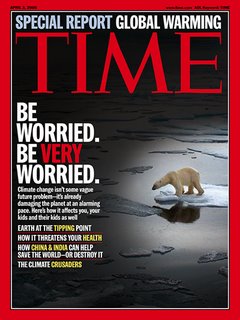Millions of gallons of raw sewage diverted into Hawaii canalOK, now, couple that with this article from this week's Time Magazine:
March 29, 2006 2:18 AM
A state Health Department spokesman says, for the most part, the current's been taking the sewage straight out to sea, but he adds, "that could change." There's also concern about possible damage to coral reefs and other marine life.
The 42-inch sewer main cracked open last Friday after heavy rain flooded an aging sewer system.
Residents of the U.S. Gulf Coast don't have to be reminded that water can be a killer. You can usually evacuate people ahead of a major storm, but you can't evacuate infrastructure. "Thirteen of the 20 largest cities in the world happen to be located at sea level," says Dr. Cindy Parker of the Johns Hopkins School of Public Health in Baltimore, Md. That means that where people are most at risk from floods, so are hospitals and water-treatment plants. As we have seen in New Orleans, the health effects of losing those facilities persist long after the water has receded.So what's that article all about?
Another predicted consequence of global warming is heavier downpours, leading to more floods. The immediate hazard is drowning, but the larger issue is water quality. To take just one example, more than 700 U.S. cities--most of them older communities in the Northeast, Northwest and Great Lakes area--have sewer systems that regularly overflow into water supplies during heavy rainstorms, mixing dirty and clean water and sometimes requiring mandatory boiling to make contaminated tap water safe. A heavy rainfall preceded the majority of waterborne-disease outbreaks in the U.S. over the past 60 years, says Dr. Jonathan Patz of the University of Wisconsin at Madison.
Not water quality, but how global warming affects all of us, even those who believe that things will actually get better with the elimination of cold winters.
In fact, Time published an entire issue devoted to global warming. Ten years too late, in my book, but an issue nonetheless, and I urge you to go get a copy and read it.

It seems that even the nutcases on the right are getting the message. Hell, WALMART is going green now! Believe it or not, what we thought would take generations to happen is happening today. Right now. In front of our eyes. Even Al Gore couldn't have in his wildest dreams imagine it would be such a sudden change, but it's here.
It's a very even-handed discussion of the facets of the global warming crisis, from what's at stake to what we as individuals can do about the problem.
For example, do you know what your carbon footprint is? How much carbon you use in a year? Do you take steps to "pay back" to the environment for your waste products, by planting trees and taking steps to minimize your carbon footprint?
Time tells you where you can go to find that out (so will I. It's carbonfund.org.)
Oh...drowning polar bears...well, it seems that the Arctic ice cap is deteriorating so badly that polar bears, normally very strong swimmers, get so tired swimming from the now-more distant ice floes that they end up drowning in the very water that sustains their food supply.
Please read this issue.



